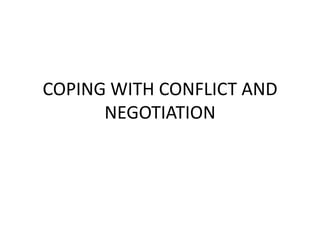Coping with conflict and negotiation
- 1. COPING WITH CONFLICT AND NEGOTIATION
- 4. Everybody not 丑补辫辫测…?
- 5. Transitions in Conflict Thought
- 6. Conflict is viewed negatively The Traditional View of Conflict Conflict is a natural occurrence The Human Relations View of Conflict
- 7. Conflict is absolutely necessary for a group to perform effectively The Interactionist View of Conflict
- 8. The Conflict Process has five stages…
- 9. STAGE I: Potential Opposition or Incompatibility
- 10. Three Categories ? Communication -misunderstandings and noise ? Structure -degree of specialization, leadership styles, reward systems ? Personal Variables -include personality, emotions, values
- 11. WHAT?!
- 12. LEADERS?!
- 13. WHY HAPPY?!
- 14. STAGE II: Cognition and Personalization
- 16. ? Felt Conflict
- 17. Keep in mind two points.. ? Stage II is important because its where conflict issues tend to be defined. ? Emotions play a major role in shaping perceptions.
- 18. Stage 3: Intentions COLLABORATING Assertive COMPETING Assertiveness COMPROMISING Unassertive AVOIDING ACCOMODATING Uncooperative Cooperative Cooperativeness
- 19. Stage 4: Behavior Annihilatory Overt efforts to destroy the other party Conflict Aggressive physical attacks Threats and ultimatum Assertive verbal attacks Overt questioning or challenging of others Minor disagreements or misunderstanding No Conflict
- 20. Stage 4: Behavior Conflict-resolution Techniques Problem Solving Super ordinate Goals Expansion of Resources Avoidance Smoothing Compromise Authoritative Command Altering the Human Variable Altering the Structural Variables
- 21. Stage 4: Behavior Conflict-Stimulation Techniques Communication Bringing in Outsiders Restructuring the Organization Appointing a Devil’s Advocate
- 22. Stage 5: Outcomes ?Functional Outcomes ?Dysfunctional Outcomes





















